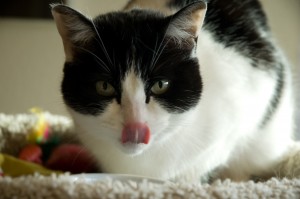Amazing the number of people who scowl and tell me I’m spoiling my animal family.
 It flummoxes me. These people, ‘the complainers,’ don’t just turn up their noses at me and my kids. They’re rude about disapproving of people (like me) who treat our animal family as something more than discardable toys, and in public no less.
It flummoxes me. These people, ‘the complainers,’ don’t just turn up their noses at me and my kids. They’re rude about disapproving of people (like me) who treat our animal family as something more than discardable toys, and in public no less.
I’m spoiling my family? Huh. Actually, I’m taking care of them. Like equals.
My eldest dog is cold a lot, so she wears a fleece jacket, indoors and out, during the cool months (a lot of those in Seattle). My younger dog prefers to be cool. The dogs and cat are safely constrained on car trips. They all get quality food and pure water. Cool toys and treats. Clean groomed bodies and comfy beds (often mine). Love and attention. An interesting, stimulating environment. Consideration for their bodies, their minds, their souls.
‘The complainers’ act like ‘spoiling’ is a dirty word. Like the ‘spoilers’ are guilty of some horrible offense.
Like it’s any of their business. Like they have a clue about how to really behave in the world.
So let me tell you. And them.
Treating everyone, human or animal, respectfully as equals is how the world goes from okay to fabulous. It’s how we create a happy balanced planet.
Starting by really getting it that everyone, and everything, has feelings. We can make others, including animals, happy or fearful by how we treat them.
My animal family gets treated as family, as beings who deserve to be respected, made comfortable and pleased. As equals. So what that they’re not human? What matters is that compassion, consideration, attention, and just plain fun aren’t reserved for humans. That we all have space to be animals, and humans, together. Without judgment.
What matters is that we’ve created a family that works for us, that together we’re safe, nurtured, and loved. That we give each other the best chance to be our best, whatever that is. That we pay attention to each other’s needs and interests. Isn’t that common courtesy? Compassion in action? Respect?
If that’s ‘spoiling,’ then let there be spoiling in a world that badly needs it! Starting with the people who don’t get it!
So you frowners and complainers, I hope you don’t have animals in your household. Or, maybe, other humans. Because when I hear you say ‘spoiled’ it sounds like you’re caught in that loop of wearing hair shirts with your perpetual frowns, of suffering through life instead of enjoying it, of making life miserable because it’s somehow supposed to be. Of disrespecting yourselves while you’re disrespecting others. Of not really caring about anything, or anyone, around you as much as you care about your narrow-minded viewpoint. It’s sad, and pointless.
Does minding my business for me make yours that much easier? I hope not!
At our house, everybody’s equal. We learn new things about each other every day. It isn’t always fun, but it’s always worth it. We try to model our respect and compassion in the world. Even for ‘the complainers.’
My dogs, my cat, they ain’t spoiled. They’re respected.
‘Spoiling’ is a dirty word, the way the complainers use it. So don’t. Try a little respect on yourself. You just might find that ‘spoiling’ is word, and a mindset, you’re better off without. The rest of us sure are.
(c) 2011 Robyn M Fritz
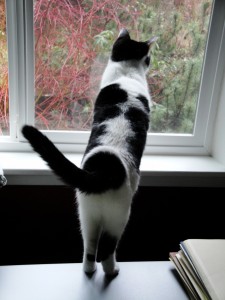 We live in a small condo: just me, two Cavalier spaniels (Murphy and Alki), and Grace the Cat. Well, okay, let’s include my crystal partner, Fallon, and Raymond, a fifty-something jade tree who spreads out like an oak.
We live in a small condo: just me, two Cavalier spaniels (Murphy and Alki), and Grace the Cat. Well, okay, let’s include my crystal partner, Fallon, and Raymond, a fifty-something jade tree who spreads out like an oak.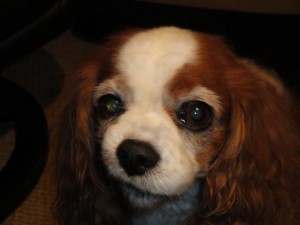 Have you always wanted to talk with an animal? And hear it talk back?
Have you always wanted to talk with an animal? And hear it talk back? Toys are a big part of the magical goofy fun side of family life. In our case, it’s a multi-species family life, which means we are a woman, two Cavaliers, and a goofy eight-pound cat.
Toys are a big part of the magical goofy fun side of family life. In our case, it’s a multi-species family life, which means we are a woman, two Cavaliers, and a goofy eight-pound cat. I was Cat’s Eye Writer’s first guest poster!
I was Cat’s Eye Writer’s first guest poster!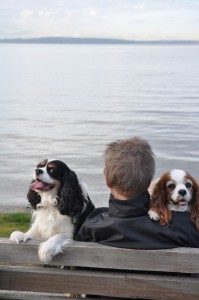 There are so many people doing animal communication that they’ve begun to specialize. I don’t do animal communication exclusively. I communicate with all life, from animals to businesses, homes, and nature, including wild/domestic land and weather systems.
There are so many people doing animal communication that they’ve begun to specialize. I don’t do animal communication exclusively. I communicate with all life, from animals to businesses, homes, and nature, including wild/domestic land and weather systems.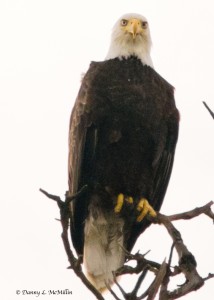 This week we’ve all heard how incompetent we are: according to the media, none of us pee enough or understand that nuclear power was idiotic to begin with. Some of us do and did. That includes me. How about you?
This week we’ve all heard how incompetent we are: according to the media, none of us pee enough or understand that nuclear power was idiotic to begin with. Some of us do and did. That includes me. How about you?